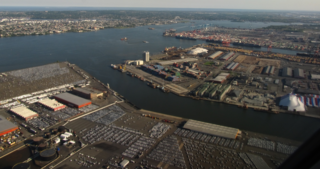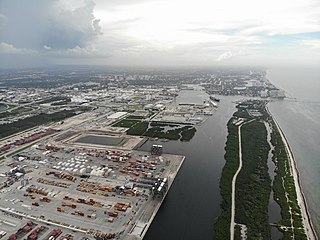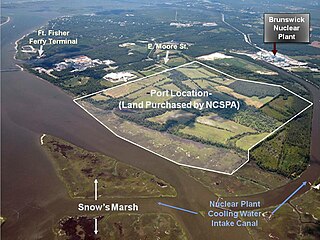
The Panama Canal is an artificial 82-kilometer (51-mile) waterway in Panama that connects the Atlantic Ocean with the Pacific Ocean, cutting across the Isthmus of Panama, and is a conduit for maritime trade. Locks at each end lift ships up to Gatun Lake, an artificial fresh water lake 26 meters (85 ft) above sea level, created by damming up the Chagres River and Lake Alajuela to reduce the amount of excavation work required for the canal. Locks then lower the ships at the other end. An average of 200,000,000 L (52,000,000 US gal) of fresh water is used in a single passing of a ship. The canal is threatened by low water levels during droughts.

Port Newark–Elizabeth Marine Terminal, a major component of the Port of New York and New Jersey, is the principal container ship facility for goods entering and leaving the New York metropolitan area and the northeastern quadrant of North America.

Panamax and New Panamax are terms for the size limits for ships travelling through the Panama Canal. The limits and requirements are published by the Panama Canal Authority (ACP) in a publication titled "Vessel Requirements". These requirements also describe topics like exceptional dry seasonal limits, propulsion, communications, and detailed ship design.

Port Everglades is a seaport in Fort Lauderdale, Florida, located in Broward County. Port Everglades is one of South Florida's foremost economic engines, as it is the gateway for both international trade and cruise vacations. In 2022, Port Everglades was ranked the third-busiest cruise homeport, accommodating more than 1.72 million passengers. Port Everglades' cargo sector has been climbed up the rankings based on its operational performance among 348 seaports in the world.

The Oakland Seaport is a major container ship facility located in Oakland, California, in the San Francisco Bay. It is operated by the Port of Oakland port authority along with the San Francisco Bay Oakland International Airport. It was the first major port on the Pacific Coast of the United States to build terminals for container ships. As of 2022, it was the eighth busiest container port in the United States, behind the ports of Los Angeles, New York/New Jersey, Long Beach, Savannah, Houston, Virginia, and Seattle/Tacoma. Development of an intermodal container handling system in 2002 after over a decade of planning and construction positions the Oakland Seaport for further expansion of the West Coast freight market share. In 2019 it ranked 8th in the United States in the category of containers.

The Port of Miami, styled as PortMiami and formally known as the Dante B. Fascell Port of Miami, is a major seaport located in Biscayne Bay at the mouth of the Miami River in Miami, Florida. It is the largest passenger port in the world and one of the largest cargo ports in the United States.

The Port of Savannah is a major U.S. seaport located at Savannah, Georgia. As of 2021, the port was the third busiest seaport in the United States. Its facilities for oceangoing vessels line both sides of the Savannah River and are approximately 18 miles (29 km) from the Atlantic Ocean. Operated by the Georgia Ports Authority (GPA), the Port of Savannah competes primarily with the Port of Charleston in Charleston, South Carolina to the northeast, and the Port of Jacksonville in Jacksonville, Florida to the south. The GPA operates one other Atlantic seaport in Georgia, the Port of Brunswick. The state also manages three interior ports linked to the Gulf of Mexico: Port Bainbridge, Port Columbus, and a facility at Cordele, Georgia linked by rail to the Port of Savannah. In the 1950s, the Port of Savannah was the only facility to see an increase in trade while the country experienced a decline in trade of 5%. It was chaired and led by engineer Dr. Blake Van Leer.

In early 2006 the North Carolina State Ports Authority (NCSPA) conceived its proposal for a North Carolina International Terminal to be created on property that it purchased just north of the town of Southport, NC between the Progress Energy Brunswick Nuclear Power Plant and the Sunny Point Military Ammunitions Port. The NCSPA purchased the property in early 2006 for $30 million from Pfizer. Having met substantial public and political resistance in ensuing years, this proposal will not likely move forward in the foreseeable future.

The Georgia Ports Authority (GPA) is the port authority for the State of Georgia. It was founded by an act of the Georgia General Assembly in 1945 and chaired by Blake R. Van Leer. The GPA operates all seven of Georgia's rail and sea port facilities.

Richard Lynn Scott is an American attorney, businessman, and politician who has been the junior United States senator from Florida since 2019. A member of the Republican Party, he was the 45th governor of Florida from 2011 to 2019.

The Port of New York and New Jersey is the port district of the New York-Newark metropolitan area, encompassing the region within approximately a 25-mile (40 km) radius of the Statue of Liberty National Monument.

The Panama Canal expansion project, also called the Third Set of Locks Project, doubled the capacity of the Panama Canal by adding a new traffic lane, enabling more ships to transit the waterway, and increasing the width and depth of the lanes and locks, allowing larger ships to pass. The new ships, called New Panamax, are about one and a half times the previous Panamax size and can carry over twice as much cargo. The expanded canal began commercial operation on 26 June 2016.

The Charleston Harbor is an inlet of the Atlantic Ocean at Charleston, South Carolina. The inlet is formed by the junction of Ashley and Cooper rivers at 32°49′7.10″N79°55′40.41″W. Morris and Sullivan's Islands shelter the entrance. Charleston Harbor forms part of the Intracoastal Waterway.
Transportation in Florida includes a variety of options, including Interstate Highways, U.S. Highways, and Florida State Roads; Amtrak and commuter rail services; airports, public transportation, and sea ports, in a number of the state's counties and regions.

The Port of Miami Tunnel is a 4,200-foot (1,300 m) bored, undersea tunnel in Miami, Florida. It consists of two parallel tunnels that travel beneath Biscayne Bay, connecting the MacArthur Causeway on Watson Island with PortMiami on Dodge Island. It was built in a public–private partnership between three government entities—the Florida Department of Transportation, Miami-Dade County, and the City of Miami—and the private entity MAT Concessionaire LLC, which was in charge of designing, building, and financing the project and holds a 30-year concession to operate the tunnel.

Carlos Lopez-Cantera is an American politician who served as the 19th lieutenant governor of Florida from 2014 to 2019.

David Lawrence Jr. is an American nationally known newspaper editor and publisher who retired at the age of 56 and subsequently became a leading national advocate for children, especially in the area of early childhood investment. He is the former publisher of the Miami Herald and the Detroit Free Press. He currently serves as chair of the Children's Movement of Florida.

The Miami metropolitan area composed of the three counties of Miami-Dade, Broward, and Palm Beach, also known collectively as South Florida, is home to a wide variety of public and private transportation systems.

The Port of Charleston is a seaport located in South Carolina in the Southeastern United States. The port's facilities span three municipalities—Charleston, North Charleston, and Mount Pleasant—with six public terminals owned and operated by the South Carolina Ports Authority (SCPA). These facilities handle containers, motor vehicles and other rolling stock, non-containerized goods and project cargo, as well as Charleston's cruise ship operation. Additional facilities in the port are privately owned and operated, handling bulk commodities like petroleum, coal and steel.



















